|
IIMARY MCREE BLACK BROWN 1819-1907
|
Website Link Index | ||||||||||||||||||||||||||
|
6th Wife of Captain James Brown:
A UTAH
PIONEER OF 1847
|
|
A SKETCH OF THE LIFE OF MARY MCREE BLACK BROWN Prepared by her granddaughter Mary Harriet "Hattie" Critchlow Jensen Mary McRee [McCree, McRae] Black Brown was born October 17, 1819 [28 October 1820] Copiah County, Mississippi, the daughter of William McRee [or McRae] and Mary McCorkins. Her parents were of Scottish descent and had immigrated to Mississippi from North Carolina about 1816. He was a wealthy planter and doctor of medicine of high standing. [Dr. McRee owned 100 slaves, but as soon as it was possible to do so he gave all his slaves their freedom and retained them at a wage to work on his large plantation. He provided for them well. Mary had every comfort and luxury available, even a personal maid.] In her young days when she was very young, and her father married a life-long friend of his deceased wife, Mary Warnock. She was a very devoted and wise stepmother, Mary was taught to sew by the family seamstress, and when she learned to make good buttonholes her brother, William, made her a present of two silk dresses when silk was very much more expensive than it is today. She was also taught to cook and all her life was considered a splendid cook of the old Southern type. [Mary was also well taught in the scriptures.] Mary at twenty-two years of age married George David Black [of Wolf Clan], son of a neighboring planter, Charles Black [1795-1865] and Rebecca Brewer Black [1797-1868] of Copiah, Mississippi. When they set up housekeeping, they had four colored servants. In 1841 Mary and her husband George joined the Mormon Church, having been converted to the faith by Daniel Tyler. [Her conversion angered her family, they disowned her.] Mary had always been of a religious turn of mind. Her parents were very strict in observing the Sabbath. No work was done by the family or servants on that day. Everything was prepared on Saturday, and all went to church on Sunday. Mary spent part of Sunday over at the quarters of the slave, teaching them about Jesus and in reading the Bible to them. Her father had a hundred slaves. He was opposed to slavery, so he gave all of his slaves their freedom, but retained them to work on his plantation and provided for them.
Children of George Black and Mary McRee (McRae) Black
|
1
Isabella BlackBorn: 6 October 1838 at Copiah County, Mississippi Infant Died: 9 October 1838 at Nauvoo, Hancock, Illinois
|
2
Melissa BlackBorn: 8 March 1849 at Infant Died: 14 Mar 1841 at Nauvoo, Hancock, Illinois
|
3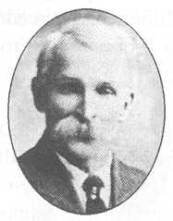
George David Black Jr.Born: 18 February 1841 at Copiah County, Mississippi Married: Mary Hunt on February 16, 1861 at Ogden, Weber, County Died: 7 April 1913 at Wilford, Fremont, Idaho
|
4
Elizabeth BlackBorn: 12 April 1842 at Child Died: 30 January 1846 at Nauvoo, Hancock, Illinois
|
5
Rebecca BlackBorn: 1 August 1844 at Nauvoo, Hancock, Illinois Infant Died: 12 September 1844 at Nauvoo, Hancock, Illinois
|
In 1845 [1843] Mary and her husband moved to Nauvoo. When they joined the Church her father told her she was being led astray by the devil, so when they left for Nauvoo they gave up family, friends and their land and property which they could not dispose of. Mary had a half section of valuable timberland, which her father had given her as a "gift of love" at the time of her marriage. This was later sold for taxes.
After arriving in Nauvoo, Mr. Black worked on the Nauvoo Temple for two years, and later engaged in the mercantile business. He took a partner in with him and was successful until his health failed him. He died of malaria in 1845. The partner of Mr. Black, a Mr. Gully, defrauded Mary of every cent that was invested in the business. He was afterwards excommunicated from the Church.
During all of these years, Mary had not heard a word from her father. She had buried four little girls [Isabella, Melissa, Elizabeth, and Rebecca are named in the PAF files] and the death of her husband greatly tried her. Falling in health and destitute of means, her husband’s folks in Mississippi who had become converted to Mormonism wrote her to come back to Mississippi. Her husband, George, on his deathbed had told her not to go back to Mississippi, fearing that her people would persuade her to stay. He had practically given his life for his religion as the doctors had told him that if he would go back to a warm climate, he would recover his health. But he refused saying "I can either live or die for the Gospel, whichever God desires of me."
Mary became very ill, and the doctors told her she would go as her husband had unless she went away from that climate. Mary refused to go but sent for the Prophet Joseph and he brought Brigham Young with, and blessed her, and told her to go home to her husband’s people until spring. They told her she would recover and would live to do much good.
She took the advice of the Prophet and went back to Mississippi. While there, she made peace with her father who felt more favorable towards his daughter. Her stepmother who had always been so good to her, stood by her in her trials, as she was called upon to give up her last little daughter Elizabeth Black in 1846, leaving her with one little son, George David Black Jr., five years old. During all this time her brothers and sisters ignored her.
|
Captain James Brown |
In the spring Daniel Tyler with others of the Saints in Mississippi took Mary and her little boy, George David Black, back to Nauvoo. Mary took this child to Brigham Young and told him that this was the only child she had left and she did not want to lose him. Their family history stated that Brigham Young took the little boy down to the Mississippi River and baptized him, then sealed him up against all sickness and disease. He came on to Utah with Captain James Brown and lived in Ogden, Utah. He was later asked to help colonize the area of Oxford, Idaho. George David Black married and had thirteen children, but never had a sick day in his life. He was killed in a wagon accident in 1913. When they reached Council Bluffs, Iowa, the government drafted five hundred men for the war with Mexico. At Council Bluffs, James enlisted in the Mormon Battalion as Captain of Company "C". Around the time of the exodus from Nauvoo, James Brown was called and encouraged by the leadership to propose marriage to her and she was married to him as the Mormon Battalion was mustering out on July 16,1846. Mary became one of the laundresses for the Battalion and took her son with her
|
Also on the Mormon Battalion trek were James Brown's sons from his first wife, Martha Stephens, Alexander Brown and Jesse Sowell Brown, as well as his wife Mary McRee Black's son, George David Black. James Brown's daughter, Nancy Brown, also joined the trek with her new husband, Eleazer Davis.
|
|
|
|
Mary endured all the hardships incident to that long march, washed for sixteen men and did many hard tasks she had never done before, and was not accustumed to doing, she suffered with heat and thirst, on soldiers rations, and became footsore and weary; waited patiently in the heat or cold, in storm or blistering heat or intense cold while the men dug wells, cut down trees or undergrowth to make roads and forded streams, some of which were treacherous with quicksand. "I wasn't afraid of anything," Mary later remarked, "but the wolves."
In the Mormon Battalion Correspondence Collection found at the LDS Archives is the following letter from Mary McRee Black Brown to her former brother-in-law, Curtis Black (1820-1850):
|
Purblow [Pueblo, Pueblo County, Colorado] December 21, 1846
My Dear Brother, Role Fleeting moments role Give my best Love and feelings to sister Melinda and all the Rest if they have come on. No more at Present but with due Respect I remain your Loving Sister in the New and [Spelling as on original letter] |
After wintering in Pueblo with all of the sick of the Pueblo Battalion, where Mary was as an ministering angel to them, they finally arrived in Salt Lake Valley July 29th, 1847. Mary McRee Brown rode into the Valley on horseback, beside her husband, and President Young greeted her with the words, "And the wolves didn't get you afterall, did they?" James and Mary briefly made their home in the Fort which stood where Pioneer Park now is.
1
Mary Eliza BrownBorn: 8 November 1847 at Salt Lake Valley, Utah Married: William Fuller Critchlow on 9 December 1862 Died: 20 Mar 1903 at Ogden, Weber, Utah
|
2
Margaret BrownBorn: 17 December 1849 at Ogden, Weber, Utah Child Died: 6 February 1855 at Ogden, Weber, Utah
|
3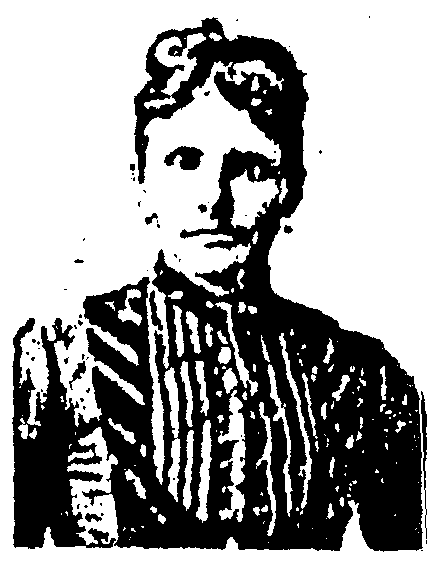
Mary Polly Ann BrownBorn: 5 May 1852 at Ogden, Weber, Utah Married: Edward Edwards around 1871 (D (2) Thomas Leonard Died: c. 1930 at Anaconda, Deer Lodge County, Montana
|
4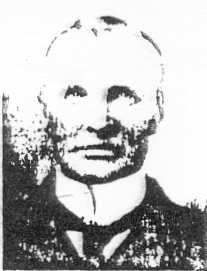
Joseph Smith BrownBorn: 4 January 1856 at Ogden, Weber, Utah Married: Sarah Wealthy Patten on 8 March 1876 Died: 22 March 1903 at Idaho Falls, Bonneville, Idaho
|
5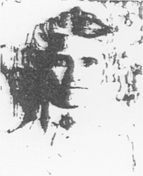
Josephine Vilate BrownBorn: 8 January 1858 at Ogden, Weber, Utah Married: Henry James Newman on 25 Oct 1875 Died: 4 April 1917 at Tremonton, Box Elder, Utah
|
While en route, as they came near Sessions Settlement which is where Centerville is today, the wagon in which they were riding tipped over into a large creek and spilled the occupants into the icy water. Fortunately, no one was injured and being near the home of Perrigrene Sessions, they were made welcome over night.
The next day they resumed their journey, over the Sand Ridge and tired and weary they arrived at their destination on the Weber River, near where the Union Depot now is.The home that awaited them was a log hut that had been occupied by Jim Bridger’s squaw wife. When Mary viewed her future home and saw the loose dirt several inches thick upon the floor, she exclaimed, "This is a hard way to serve the Lord."
The men folks shoveled out the dirt, made a fire in the fireplace and put up a one legged bedstead.
The next day they cut down a large cottonwood tree and made a cradle for little baby Mary Eliza. They also built a Dutch oven in the dooryard to roast meat in and take what little bread was rationed out for them.
The men folks (Captain Brown and his grown sons [Jesse and Alexander] by his first wife [Martha Stephens], first duty was to get the ground ready for planting their precious seed. They had plenty of cattle and milk and butter, but other food was very scarce.
Mary used to bake the meat and when it was cold, cut it in slices and they would spread butter upon it and make believe it was bread.
One day while she was engaged in cooking some meat, several big Buck Indians came bedecked in red paint and feathers and demanded the meat. By signs she explained it was for the men’s dinner.
They pointed their bows and arrows at the baby in the cradle, making Mary understand in no uncertain manner that if she didn’t give them the meat they would kill the baby. She ran to the baby, snatch it from the crib and ran to where the men were working a mile away expecting any minute to be pierced with a flying arrow, as the blood curdling yells of the Indians followed her. After this incident one of the men stayed near the cabin.
Imagine if you can how this woman must have felt. Alone, except for her family, forty miles from the nearest neighbor in a lonely wilderness of snakes, wild animals, and Indians. And compare it with the life she had before she cast her lot willingly and gladly, for the Gospel’s sake, with the Mormons.
She, though of delicate nature, and slender built, was made of the stuff pioneers are made of. She had courage, faith God, and a disposition to the make the best of conditions.
Mary learned to make cheese, and was known as the first cheese maker in Utah.
When the gold rush was on in 1849 she sold great quantities of butter and cheese to the travelers. [On December 17, 1849 her daughter Margaret was born. Margaret lived until February 6, 1855.]
She bore Captain James Brown five children, four daughters and one son, the same as she bore her first husband.
She lived to be nearly ninety years old, beloved by all who knew her for her sweet personality, generosity, unselfishness and kindness.
[When James died in 1863 Mary moved to Oxford, Idaho to be near her son, George David Black Jr.. Later she moved to Ogden to live with her daughter Josephine Vilate Brown Newman. When she was in her eighties, she lived with her daughter, Mary Eliza Critchlow.]
Her two sons, [George] David Black Jr., and Joseph Smith Brown, lived in Northern Idaho. She had not seen them for several years. Her daughter, Mary Eliza Brown Critchlow, died suddenly of pneumonia [March 20,1903 in Ogden] and her two brothers, David and Joseph were on their way to the funeral. While grandma was grief-stricken over the loss of her daughter the thought of seeing her two sons sustained her.
While en route to Ogden, they had to change trains and wait several hours at Idaho Falls. Joseph, to pass the time away, went up town. March 22, 1903, on his way back to the depot at midnight he was held up and shot to death. David took the body back to their home in Idaho and was unable to attend his sister’s funeral.
When it became necessary to tell grandma about it, none of the family felt that they could do so. Bishop McQuarrie told her of it. She looked at him with stricken eyes when he told her and whisperingly said, "Providence knows best."
Such courage and faith and acceptance of trial in the face of this double bereavement and disappointment was another indication of her wonderful character. She was a wonderful example to all of us.
Mary McRee Black Brown was sealed posthumously to her first husband, George D. Black Sr., on March 27, 1877 in the Salt Lake City Endowment House.
She passed away sometime between 2 Nov 1906 and 1 Nov 1907 and is buried in a lot close to her second husband Captain James Brown in the Ogden City Cemetery in Ogden, Utah.
![]()
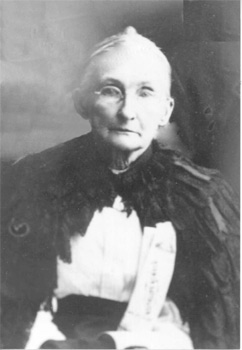
Mary McRee Black Brown - from photo where she is sitting with remainder of Mormon Battalion
at 50 Year anniversary in 1897
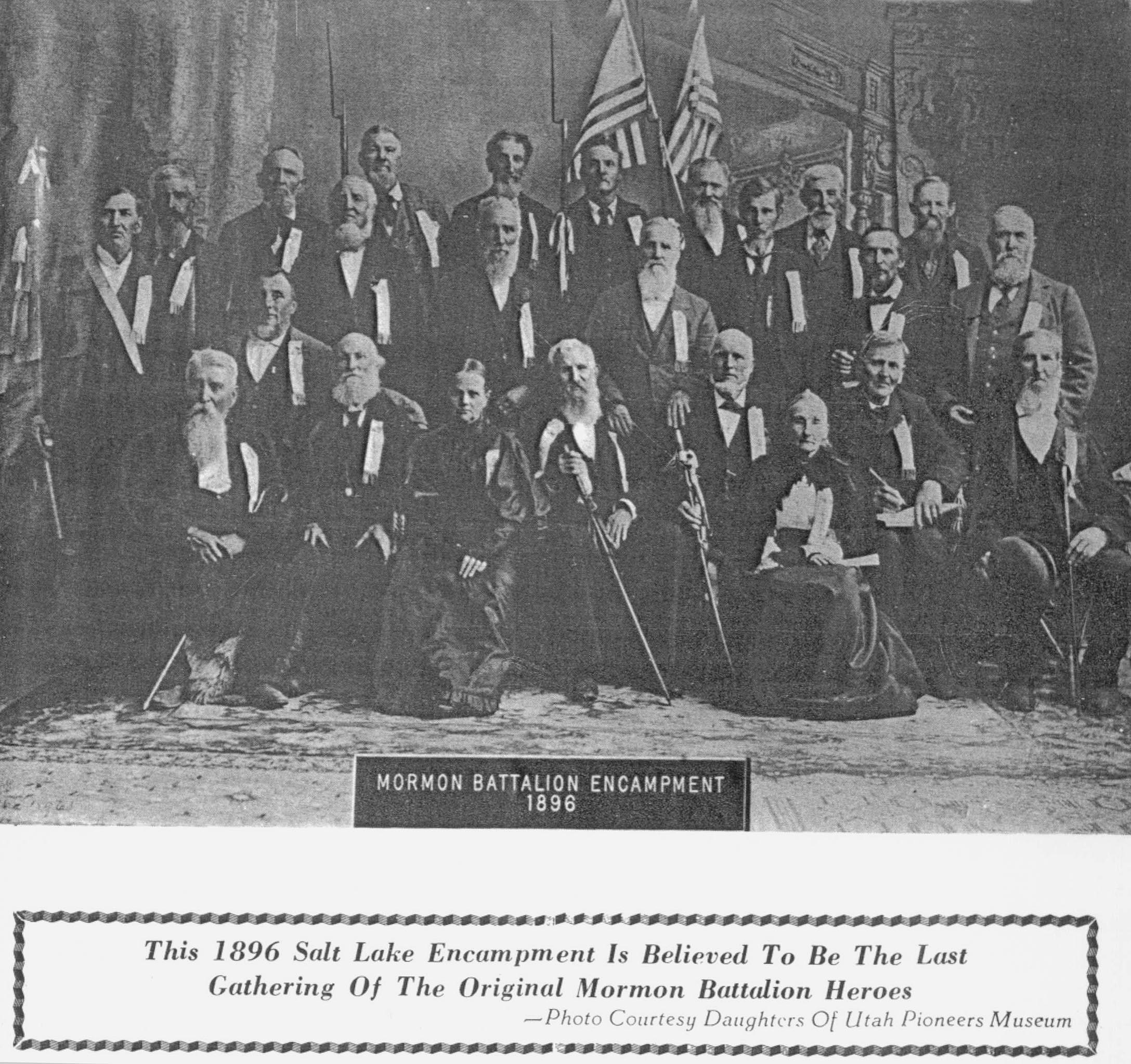
Published on the cover of The Pioneer Vol. 16 N. 5 Sept-Oct 1969
Right Click mouse on image - then click on view image - to see enlarged photo
![]()
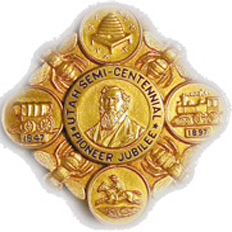
FIFTY YEAR ANNIVERSARY - PIONEER JUBILEE MEDAL![]()

by her son George David Black and his wife, Mary Hunt Black
and their daughter, Harriett Erminnie "Minnie" Black Garner
Among those who received the message of Mormonism in the beautiful valley of the Mississippi were George and Mary McCree (sp) Black who was born in Copiah County, Mississippi. They were baptized in 1841 by Daniel Tyler and that same year, George David Black, was born February 18th. The father died of malaria in 1845. After his death Mary lost two little girls with the same disease within two months. The shock was so great that she became very ill and the doctor told her that if she did not go to a warmer climate she, also would die.
During this time of sorrow she sent for Brigham Young. He answered her request bringing with him James Brown. They blessed her and told her to return to her home where she could be with her own people. She took with her the two remaing daughters and son, George David, and went to the home of her husband's people who had become Mormon converts. Again the angel of death visited her and took both of her little girls.
In the spring she returned with missionaries to Nauvoo. Shortly after George David was stricken with malaria and fearing that he, too, would die she sent for Brigham Young to come and administer to him. Brigham came as quickly as possible. "Mary," he said, "I will take him down to the Mississippi River and baptize him for his health." The boy recovered and was made well and strong again.
When the Saints were driven out of Illinois and companies were being formed to go west, James Brown invited Mary and her son to go with the company. This she was glad to do, joining the trains of snow-covered wagons in almost countless numbers that poured of Nauvoo. After reacing Council Bluffs, Iowa, James Brown proposed marriage to Mary. She accepted and they were married at that place.
When James was made Captain of Company D [Company C] of the Mormon Battalion he took Mary and George David with him on the long journey where they endured untold suffering. Mary cooked and washed for the men. Little David was her joy and consolation during these trying months. Sfter reaching Santa Fe, New Mexico, Captain Brown was detailed to take the women, children and disable soldiers to Pueblo, Colorado where they wintered. In the spring of 1847, they, with other members of the company, again took up the long journey to the valley, arriving in Salt Lake City July 29, 1847.
George David and Mary went north with Captain Brown when he was called to buy and colonize a tract of land on the present site of Ogden bought from Miles Goodyear, an ole trapper with an Indian wife. Mary lived in the log cabin with a dirt floor and the only furniture was a one-legged bed nailed to the wall. When she saw her new home forty miles from a neighbor, she exclaimed, "This is a hard way to serve the Lord." In this community she later became known as an outstanding cheesemaker. She lived to be eighty-six years of age and died a faithful Latter-day Saint.
David grew to manhood and worked many hours on the land. His education was rather meger, but his mother being a cultured woman had taught him to read from the Bible and tried to instill into his young life the wound and lasting principles which would remain with him throughout his mortal exisence. He was baptized and ordained a deacon in 1851.
While the mothers cooked meals over campfires during the sojourn with the Battalion, David often played with Mary, daughter of Captain Charles Jefferson Hunt. After the Mormon Battalion was mustered out and Captain Hunt returned to Utah, he and others, were called to colonize the San Bernardino Valley in California. Thus the children were separated until May was about fourteen years of age when her father and his family were called back to Utah on account of Johnston's Army. The Hunt family located in Ogden. Mary was then a beautiful blue-eyed, dark-haired girl. During all the years, David had retained a love for his childhood sweetheart. When he met her again he vowed that no other man should call her wife. Mary returned his love and they were married September 16, 1861 at the home of Captain Hunt, the ceremony was performed by Joseph A. West, the first bishop of Ogden. Later they were sealed in the Endowment House in Salt Lake City.
The young couple made their home in Ogden untl 1871, where four chlildren were born to them: Nancy Jane, George David, Charles Jefferson, and William Jesse. During this time the father took care of large herds of cattle out on Promontory. John Henry Smith also herded cattle in this vicinity and they became staunch friends. George David was a member of the first martial band of Ogden, playing snare drum and he was also a good violinist, playing for the town dances. He was honored as the official cannon shooter of the city. During a 4th of July celebration, while shooting the cannon, he did not get away quickly enough and received a shock which impaired his hearing for the rest of his life.
In the fall of 1871, George David moved his family to Huntsville. The snow fell so deep that winter it covered the little dugouts in which many of the people lived. David and Mary lived in a one-room log cabin and here on April 21, 1872, Harriet Erminnie was born. In March of the next year they were on the move again, settling in Oxford, Idaho, and here they stayed for eleven years. During this time five more children, Joseph Warren Black, John Franklin Black, Mary Abigail Black, Grace Black, and Henry Harrison Black came to bless their home. In 1874, George David was ordained an Elder by John Boice and, in 1875, was made Presiding Elder over the Oxford Branch, Cache Stake of Zion. He held that position for three years and then was chosen first counselor to William F. Fisher who was called from Richmond to be Bishop of the Oxford Ward. The Black family lived in Oxford until the Upper Snake River Valley was being colonized by the Mormons. George David was called by the President of the Stake, William B. Preston, to go and help build up the valley.
So once more they traveled over mountains and through deep sand, through the Bannock Indian Reservation, then a barren desert with only an Indian agency at Fort Hall. "As we drove through Portneuf we children expected every moment a band of Indians would come rushing out of some of those ravines. Finally we reached the great Snake RIver, and crossed the old toll bridge at Eagle Rock, then on to Market Lake. How the old wagon jolted over the lava beds. There were no roads, just a trail to follow. Again we reached the river north of Rexbury. When we found out we must ford the wide deep stream, our hearts almost failed us, but we had come to build a new home and knew that was the only way we could get to it. Father told us not to be afraid. We offered up a prayer to our Heavenly Father, then fater drove into the stream following the sand bar. How happy we were when we reached the opposite side of the mighty river, and reached our lone log cabin near the banks of the north Teton River, November 6, 1883.
"The snow fell that night and we never saw the bare ground again until the first of May. It was a long hard winter. There were no amusements of any kind. Neighbors had to travel back and forth on snowshoes. The older people visited with each other and read a few books they had brought with them, while the children played games and amused themselves as only children can. In March Thomas E. Ricks came from Rexburg and partly organized a Sunday School so we might have something of a spiritual nature."
As Christmas time came near, the younger children began to talk of Santa Claus which made George David and Mary very sad as seventy-five cents was the total sum of money in the house. They talked it over and decided that the children would have a little candy at least. He would drive to Rexburg, a distance of seven and one-half miles. The day before Christmas a raging blizzard came, but David hitched his horses onto an old homemade sleigh and started out. He had to ford two rivers before he reached Rexburg. At the first, the Teton, the horses broke through the ice, plunging into the icy water. David somehow got hold of the horses bridles and got them back on the bank. It was several hours later when he reached home nearly frozen. Mary, although disappointed that the children would not receive even the candy, was truly thankful that her husband was safe at home again and late that night she made a little candy of the precious sugar on hand and parched som corn. With the help of the older daughter, Minnie, she made rag dolls for the little girls using charcoal to make the hair and eyes and fruit juices to paint their cheeks. The children were overjoyed with their gifts and it can truly be said that this was one of the happiest Christmases spent by the family, for every heart in that humble home was in tune.
The spring found George David busy plowing and planting his precious seed. Along with his other duties he became superintendent of the Wilford Sunday School. He was also presiding Elder of the Wilford Branch. When the bannock Stake of Zion was organized he was chosen a member of the First High Council, and was the senior member. He often walked a distance of twelve miles to attend quorum meetings.
George David was a true friend of the Indians and learned their language. They taught him to hunt and fish and were often amazed when he caught the biggest fish. They named him "Pigga Panguitch" meaning "big fish". After forty years he went to Salt Lake City to attend the Fiftieth Anniversary of the Saints arrival in the Valley. Heree he saw an old Indian woman he had known as the young mother of one of his playmates. He stepped up to her and said, "Loanna" in her language. She was now almost blind. When she recognixed him she cried, "Pigga Panguitch", tears streaming down her face. Members of her tribe had been fed in his home and many would have given their life for him.
George David and Mary passed through all the trials and hardships incident to pioneering a new country. He filled many positions of trust, helped build new meetinghouses and schoolhouses as he was a carpenter and plasterer by trade. While living in Wilford three more children were born to them, Celia Margaret Black, Wallace Edwin Black, and Maudeline Black, the latter dying [March 28, 1899] when she was eight and a half years of age.
In 1903, George David moved his family to Grande Ronde Valley, settling in LaGrande, Oregon, where his son Jefferson Black was bishop, but they did not stay long for they wanted to be with their loved ones in their old Idaho home. When they returned he built a home at Sugar City but again they moved to Oregon to Mount Glen. They eventually moved back to Wilford where he bought another, and as he said "his last home". On April 2, 1912, while riding home from St. Anthony on a heavily loaded wagon of wheat, he was knocked off by some boys who were scuffling, between the wheels of the wagon and was so badly crushed, he died five days later.
------Minnie Black Garner
Found in "Our Pioneer Heritage -- Women and Children of the Mormon Battalion", pages 481-485.
Submitted to this site by Erold C. Wiscombe

By Minnie Moore Brown
Who can describe her appearance now? We can tell of the whitened head bowed by the years; of the toil worn patient hands; the sweet tremulous mouth; the bright eyes; but we cannot express the impression of her which we receive when taling to her or sitting in her presence. She is such a cheery little body--has such nimble fingers, and so very much to talk about. Wherever she goes, she is a welcome guest and every child who knows her loves her. It is a pleasant sight to see her surrounded by four or five of her little grandsons--she as patient and resourceful as she was forty years ago, and they so happy to be with "Gra'm."
Mary Brown was born October 28th, 1816 in Copiah County, Mississippi, her forefathers being Americans for generation back. Her father was a physician of some note in his locality and here she received the early training which prpared her to so nobly live a life of varied experiences.
She grew into womanhood, characterized by indefatigable industry and pureness of heart. While still quite young she married George Black, and together with her husband she was converted and baptized into the Church of Jesus Christ of Latter-day Saints by Elder Daniel Tyler. In 1843, Mr. Black moved his family to Nauvoo, where they lived in peace and happiness until his death in 1845.
His widow was left with a little son David, who was her chief comfort and pride. Shortly before the exodus from Nauvoo, [27 year old] Mary became the plural wife of James Brown, and with his family she began her westward march.
On the plains the call came for recruits for the U.S. Armny. We all know how cheerfully the Pioneers responded to this demand from the Government, and how quickly five hundred of our men and boys were enrolled as soldiers of "Uncle Sam". James Brown was selected as one of the five captains, and his wife Mary was advised to accompany him on the march to Mexico. She conquered her natural shrinking from such a hard life and bravely agreed to go with him, placing her faith in the Lord. Her only condition was that she might be allowed to take her son, David Black, with her.
At Council Bluffs a great farewell feast was held, during which, the dancing and singing were enjoyed by none more heartily than Mary Brown. Her face still lights up when thinking of that time. Though many hearts were sad at the necessary partngs, all placed implicit faith in God, and in the word of His prophet that not one should fall in battle. Few doubted the safe return of the soldier boys.
We can scarcely imagine the trials Mary endured on the march to Fort Leavenworth, during the tedious stop while enlistment of the Battalion into the regular army took place, and the still harder and longer march across the desert, towards Mexico.
At one time, when the men were nearly exhausted for want of water, little David Black, bravely gave the small canteenful resered for him, to relieve the sufferings of a dying soldier. His kindness of heart saved the life of the poor fellow, and shortly after, Captain Brown, who had been scouting for water, discovered a tiny spring in a great, gray rock. The water oozed out, two drips at a time, and was lost in the burning sand. With picks, the flow was enlarged to a tiny stream and for hours, the men lay or stood around it, drinking-drinking--unable to eat until their swoolen tongues were cooled.
Mary shed many bitter tears in sympathy with their sufferings, little recking of her own sorry plight. Through the darkness and the wind, the glare of the desert sun by day, and the chill of the air by night, Mary passed without a murmur. The toils of the camp fire were performed willingly, and the sick learned to bless her gentle hand. She often says now, "I wan't afraid of anything--but the wolves."
When the Battalion was mustered out at Santa Fe, and the main body of the men started for California, to Captain Brown was entrusted the care of the women, the children, and the sick. After a hurried march his company, consisting of one hundred and ten men, twenty-two women, and two small children, reached Pueblo, where immediate preparations for a long stay were commenced.
The settlement was just across a small river from a trading post, and thus supplies were obtainable. Soon the small houses built of logs roofed with dirt and with hard dirt floors, were ready for occupancy.
The weather was mild and the climate healthful. Mary very much enjoyed this calm after the storm, and was happy to nurse the sick back to strength, perform the arduous tasks of house building and housekeeping and often found time to join in the frequent merry makings the people had. God's people are always cheerful and light-hearted.
In April came the welcome command to take up the march to the Valleys of the Mountains. With earger fingers, Mary packed the belongings of the family, and once more, with her little david by her side, took her place in the heavy wagon. The journey northwards began, and again the privations of such a mode of travel had to be borne.
One night Mary dreamed that letters from Winter Quarters came to the little band. When morning dawned, she asserted her firm belief that they would that day hear from their friends. Some believed so too, influenced by their wild yearning for tidings from their long absent loved ones. Others laughed--the thing seemed too good to be true. Before the day passed, Mary, who was intently watching the horizon as the wagon swayed and creaked along, suddenly descried some dark specks bobbing and dipping like birds.
"There come the messengers," she told her husband and soon every eye was strained to see the advancing objects. Finally the messengers came riding into camp and we can imagine the welcome they received. Every man had a letter or word of some sort from his people, and excitement reigned throughout the company. Some were glad at the happy news they received--others wept at sad tidings of misfortune, death, and injustice inflicted upon helpless ones left behind. Mary's heart was especially touched by these and she says "I shall never forget that day."
The trail of the Pioneers was struck at Fort Laramie, whree the people set up a glad shout at sight of a post stuck in the ground by the road, on which was inscribed the names of Brigham Young and several others--all well known and loved.
The way-worn band reached the valley on the 28th day of July, 1847. President Young and the Twelve came out to meet them. Mary rode into the Valley on horseback, beside her husband, James Brown, and President Young greeted her with the words. "And the wolves didn't get you after all did they?"
Mary has spent her life in Utah since her first coming, watching its growth and development, earnestly working in may Church capacities. She has never been sparing of toil for others--always happy whatever her lot has been. She has lost none of her old faith in God's goodness, and meekly endures her trials.
She has been a widow many years, living in Ogden most of the time. Her daughter, Mary Eliza Brown Critchlow, was the second child born in Utah, and she, herself, was the first white woman to make her home in Weber county. Out of the five [10] children God sent her, three [6] are now [1904] dead. She is never content unless she is busy. Her brain is as clear and active as ever, although she is occasionally ill. On the whole, however, she is remarkably strong and active. Nothing pleases her more than to talk to an appreciative listener of the "Good old days, dear, when I was young, like you."
"But you are still afraid of the wolves, aren't you?" I teasingly asked her.
She responded with a smil, "Yes, dear, I"m still afraid of the wolves."
--From The Young Woman's Journal, July 1904, bound Vol. 14, pages 306-308.

http://www.utahcrossroads.org/newsv8n4.htm
When Philip St. George Cooke assumed command of the battalion in Santa Fe, he thought there were too many women, children, and sick soldiers and decided to send a second detachment to Pueblo. This group left Santa Fe, New Mexico on October 18, 1846 under James Brown, captain. They arrived in Pueblo November 17 with 92 men, 19 women and 10 children. This was the Brown Sick Detachment (Santa Fe Detachment)

Mormon Battalion Monument located on west side of I-25 just north of Albuquerque, New Mexico enroute to Santa Fe. Brown Sick Detachment (included) |
 |
Sources:
PAF - Archer files = Captain James Brown + (6) Mary McRee Black
Captain James Brown + (7) Phoebe Abigail Abbott > Orson Pratt Brown
"Pioneer Women of Faith and Fortitude, Vol. II, International Society Daughters of Utah Pioneers, Publishers Press, 1998. Page 392 (Brown) ISBN: 0-9658406-1-1
Ricketts, Norma Baldwin, “The Mormon Battalion, U.S, Army of the West, 1846-1848”, 1996. Utah State University Press, Logan, Utah. Pages 29, 31, 239.
Conquerors of the West: Stalwart Mormon Pioneers Vol. I, Edited by Florence C. Youngberg, 1999, Sons of Utah Pioneers, SLC, UT. Page 306 to 308.
LDS Church Archives Church Office Building, 50 East North Temple Street, East Wing, Second Floor, Salt Lake City, Utah 84150 --Mary McRee Black to Curtis Black, Dec 21, 1846, MS 2070, Folder 5, Mormon Battalion Correspondence Collection.
http://www.angelfire.com/folk/gljmr/1860CopiahS.html gives number of blacks owned by individuals in Copiah County, Mississippi. Indicates: CHARLES BLACK, 1 ; W. G. BLACK, 2 ; WILLIAM BLACK, 22
http://www.brownhistory.org/CJBWives_Children.htm#LovinaMitchell
Photos, items in [Brackets] and bold are among items added by Lucy Brown Archer
Copyright 2001 www.OrsonPrattBrown.org
|
|
![]()
To SEARCH THIS SITE: Use the Google.com search engine
Type....site:OrsonPrattBrown.org "TYPE NAME YOU ARE
LOOKING FOR INSIDE PARENTHESIS"...Press ENTER
A list with the search term will appear.
![]() OPB FAMILY BLOG SITE
OPB FAMILY BLOG SITE
... http://orsonprattbrownfamily.blogspot.com/
![]() PERSONAL ANCESTRAL FILE
PERSONAL ANCESTRAL FILE
... Password Access Only
![]() ADDRESS LIST FOR BROWN FAMILY
ADDRESS LIST FOR BROWN FAMILY
... Password Access Only
![]() ORSON PRATT BROWN FAMILY REUNIONS
ORSON PRATT BROWN FAMILY REUNIONS
... Easter 1986 through October 2005
... ARTICLES OF ASSOCIATION - BY-LAWS
COMMENTS AND INPUT ON ARTICLES
... Published December 2007:
![]() "ORSON PRATT BROWN AND HIS FIVE WONDERFUL WIVES VOL. I and II"
"ORSON PRATT BROWN AND HIS FIVE WONDERFUL WIVES VOL. I and II"
![]() By Erold C. Wiscombe
By Erold C. Wiscombe
... Published March 2009:
![]() "CAPTAIN JAMES BROWN AND HIS 13 WIVES"
"CAPTAIN JAMES BROWN AND HIS 13 WIVES"
(unfortunately the publisher incorrectly changed the photo
and spelling of Phebe Abbott Brown Fife's name
after it was proofed by this author)
Researched and Compiled by Erold C. Wiscombe
... Published 2012:
"Finding Refuge in El Paso"
By Fred E. Woods [ISBN: 978-1-4621-1153-4]
Includes O.P Brown's activities as Special Church Agent in El Paso
and the Juarez Stake Relief Committee Minutes of 1912.
...Published 2012:
"Colonia Morelos: Un ejemplo de ética mormona
junto al río Bavispe (1900-1912)"
By Irene Ríos Figueroa [ISBN: 978-607-7775-27-0]
Includes O.P. Brown's works as Bishop of Morelos. Written in Spanish.
...Published 2014:
"The Diaries of Anthony W. Ivins 1875 - 1932"
By Elizabeth Oberdick Anderson [ISBN: 978-156085-226-1]
Mentions O.P. Brown more than 30 times as Ivins' companion.
... To be Published Soon:
![]() "CAPTAIN JAMES BROWN 1801-1863:
"CAPTAIN JAMES BROWN 1801-1863:
![]() TEMPER BY NATURE, TEMPERED BY FAITH"
TEMPER BY NATURE, TEMPERED BY FAITH"
![]() Send Comments and Information to:
Send Comments and Information to:
![]() OrsonPrattBrown@gmail.com
OrsonPrattBrown@gmail.com
... FAMILY GROUP PHOTOS
... FAMILY REUNIONS
... Lily Gonzalez Brown 80th Birthday Party-Reunion
![]() July 14, 2007 in American Fork, Utah
July 14, 2007 in American Fork, Utah
...Gustavo Brown Family Reunion in October 2007
... FAMILY MEMBERS WHO DIED RECENTLY
... NEWS, WEDDINGS, BABIES, MORE
... HELP US IDENTIFY THESE ANCESTORS
![]() Send Additions and Information to:
Send Additions and Information to:
![]() OrsonPrattBrown@gmail.com
OrsonPrattBrown@gmail.com
...... Wives and 35 Children Photo Chart
...... Chronology
...... Photo Gallery of OPB
...... Letters
...... Biographical Sketch of the Life Orson Pratt Brown
...... History of Orson Pratt Brown by Orson P. Brown
...... Journal & Reminiscences of Capt. Orson P. Brown
...... Memories of Orson P. Brown by C. Weiler Brown
...... Orson Pratt Brown by "Hattie" Critchlow Jensen
...... Orson Pratt Brown by Nelle Spilsbury Hatch
...... Orson Pratt Brown by W. Ayrd Macdonald
...... Wives and 29 / 43 Children Photo Chart
...... Captain James Brown's Letters & Journal
...... Brown Family Memorabilia
...... Mormon Battalion 1846-1847
...... Brown's Fort ~ then Brownsville, Utah
...... Chronology of Captain James Brown
- James Brown of Rowan County, N.C. 1757-1823
- Mary Williams of Rowan County, N.C. 1760-1832
- Stephen Joseph Abbott of, PA 1804-1843
- Abigail Smith of Williamson, N.Y. 1806-1889
- John Fife of Tulliallan, Scotland 1807-1874
- Mary Meek Nicol, Carseridge, Scotland 1809-1850
- Martha "Mattie" Diana Romney Brown 1870-1943
![]()
![]()
![]()
- Jane "Jennie" Bodily Galbraith Brown 1879-1944
![]()
![]()
- Elizabeth Graham MacDonald Webb Brown 1874-1904
- Eliza Skousen Brown Abbott Burk 1882-1958
- Angela Maria Gavaldón Brown 1919-1967
![]()
- (Martha) Carrie Brown (child) 1888-1890
- (Martha) Orson Pratt Brown, Jr. (child) 1890-1892
- (Martha) Ray Romney Brown 1892-1945
- (Martha) Clyde Romney Brown 1893-1948
- (Martha) Miles Romney Brown 1897-1974
- (Martha) Dewey B. Brown 1898-1954
- (Martha) Vera Brown Foster Liddell Ray 1901-1975
- (Martha) Anthony Morelos Brown 1904-1970
- (Martha) Phoebe Brown Chido Gardiner 1906-1973
- (Martha) Orson Juarez Brown 1908-1981
- (Jane) Ronald Galbraith Brown 1898-1969
- (Jane) Grant "Duke" Galbraith Brown 1899-1992
- (Jane) Martha Elizabeth Brown Leach Moore 1901-1972
- (Jane) Pratt Orson Galbraith Brown 1905-1960
- (Jane) William Galbraith Brown (child) 1905-1912
- (Jane) Thomas Patrick Porfirio Diaz Brown 1907-1978
- (Jane) Emma Jean Galbraith Brown Hamilton 1909-1980
- (Elizabeth) (New born female) Webb 1893-1893
- (Elizabeth) Elizabeth Webb Brown Jones 1895-1982
- (Elizabeth) Marguerite Webb Brown Shill 1897-1991
- (Elizabeth) Donald MacDonald Brown 1902-1971
- (Elizabeth) James Duncan Brown 1904-1943
- (Eliza) Gwen Skousen Brown Erickson Klein 1903-1991
- (Eliza) Anna Skousen Brown Petrie Encke 1905-2001
- (Eliza) Otis Pratt Skousen Brown 1907-1987
- (Eliza) Orson Erastus Skousen Brown (infant) 1909-1910
- (Eliza) Francisco Madera Skousen Brown 1911-1912
- (Eliza) Elizabeth Skousen Brown Howell 1914-1999
- (Angela) Silvestre Gustavo Brown 1919-
- (Angela) Bertha Erma Elizabeth Brown 1922-1979
- (Angela) Pauly Gabaldón Brown 1924-1998
- (Angela) Aaron Aron Saul Brown 1925
- (Angela) Mary Angela Brown Hayden Green 1927
- (Angela) Heber Jedediah Brown (infant) 1936-1936
- (Angela) Martha Gabaldón Brown Gardner 1940
- Stephen Abbott Brown 1851-1853
- Phoebe Adelaide Brown Snyder 1855-1930
- Cynthia Abigail Fife Layton 1867-1943
- (New born female) Fife 1870-1870
- (Toddler female) Fife 1871-1872
- (Martha Stephens) John Martin Brown 1824-1888
- (Martha Stephens) Alexander Brown 1826-1910
- (Martha Stephens) Jesse Stowell Brown 1828-1905
- (Martha Stephens) Nancy Brown Davis Sanford 1830-1895
- (Martha Stephens) Daniel Brown 1832-1864
- (Martha Stephens) James Moorhead Brown 1834-1924
- (Martha Stephens) William Brown 1836-1904
- (Martha Stephens) Benjamin Franklin Brown 1838-1863
- (Martha Stephens) Moroni Brown 1838-1916
- (Susan Foutz) Alma Foutz Brown (infant) 1842-1842
- (Esther Jones) August Brown (infant) 1843-1843
- (Esther Jones) Augusta Brown (infant) 1843-1843
- (Esther Jones) Amasa Lyman Brown (infant) 1845-1845
- (Esther Jones) Alice D. Brown Leech 1846-1865
- (Esther Jones) Esther Ellen Brown Dee 1849-1893
- (Sarah Steadwell) James Harvey Brown 1846-1912
- (Mary McRee) George David Black 1841-1913
- (Mary McRee) Mary Eliza Brown Critchlow1847-1903
- (Mary McRee) Margaret Brown 1849-1855
- (Mary McRee) Mary Brown Edwards Leonard 1852-1930
- (Mary McRee) Joseph Smith Brown 1856-1903
- (Mary McRee) Josephine Vilate Brown Newman 1858-1917
- (Phebe Abbott) Stephen Abbott Brown (child) 1851-1853
- (Phebe Abbott) Phoebe Adelaide Brown 1855-1930
- (Cecelia Cornu) Charles David Brown 1856-1926
- (Cecelia Cornu) James Fredrick Brown 1859-1923
- (Lavinia Mitchell) Sarah Brown c. 1857-
- (Lavinia Mitchell) Augustus Hezekiah Brown c. 1859
- (Diane Davis) Sarah Jane Fife White 1855-1932
- (Diane Davis) William Wilson Fife 1857-1897
- (Diane Davis) Diana Fife Farr 1859-1904
- (Diane Davis) John Daniel Fife 1863-1944
- (Diane Davis) Walter Thompson Fife 1866-1827
- (Diane Davis) Agnes Ann "Aggie" Fife 1869-1891
- (Diane Davis ) Emma Fife (child) 1871-1874
- (Diane Davis) Robert Nicol Fife (infant) 1873-1874
- (Diane Davis) Barnard Fife (infant) 1881-1881
- (Cynthia Abbott) Mary Lucina Fife Hutchins 1868-1950
- (Cynthia Abbott) Child Fife (infant) 1869-1869
- (Cynthia Abbott) David Nicol Fife 1871-1924
- (Cynthia Abbott) Joseph Stephen Fife (child) 1873-1878
- (Cynthia Abbott) James Abbott Fife (infant) 1877-1878
- (Diana) Caroline Lambourne 18461979
- (Diana) Miles Park Romney 1843-1904
- (Jane) Emma Sarah Bodily 1858-1935
- (Jane) William Wilkie Galbraith 1838-1898
- (Elizabeth) Alexander F. Macdonald 1825-1903
- (Elizabeth) Elizabeth Atkinson 1841-1922
- (Eliza) Anne Kirstine Hansen 1845-1916
- (Eliza) James Niels Skousen 1828-1912
- (Angela) Maria Durán de Holguin 1876-1955
- (Angela) José Tomás Gabaldón 1874-1915
|
Contact Us: |